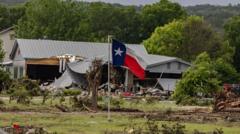In the wake of a prolonged drought, the water-sharing conflict between the US and Mexico has intensified, with both nations holding varying interpretations of their treaty obligations. Farmers on both sides express grievances, highlighting the struggle for resources in a changing climate that challenges outdated agreements.
"Water Divide: The Escalating Dispute Over Scarcity Between the US and Mexico"

"Water Divide: The Escalating Dispute Over Scarcity Between the US and Mexico"
The ongoing water crisis showcases the tensions between Texas and Mexico, as they grapple with their obligations under a historical treaty amidst severe drought.
The article text:
The water-sharing conflict between the United States and Mexico is escalating amid a critical drought in northern Mexico, particularly in the state of Chihuahua. Residents of San Francisco de Conchos have been gathering in prayer as they confront dwindling water supplies from Lake Toronto, from which the crucial La Boquilla dam draws. Having experienced a relentless 30-month drought, farmers have become increasingly desperate, monitoring the low water levels that now stand at less than 14% of capacity.
Historically, the 1944 treaty mandates that Mexico must deliver 430 million cubic meters of water annually from the Rio Grande to the US. In exchange, the US supplies significantly larger amounts—approximately 1.85 billion cubic meters—to aid border cities like Tijuana and Mexicali. However, the Mexican government has fallen behind on its water deliveries, with many attributing this shortfall to ongoing environmental stressors. As political pressure mounts from Texas, and with former President Trump issuing threats regarding tariffs and sanctions, tensions are likely to rise.
Local farmers express diverging views on the water-sharing agreement. Brian Jones, a Texan farmer, argues Mexico is hoarding water while his counterparts argue that their primary responsibility is to meet their own agricultural needs first. Reports from Texas indicate frustration at the perceived lack of cooperation from Mexican farmers, who they believe should be more accountable under the treaty.
On the Mexican side, farmers defend their practices, asserting that the ongoing drought impedes their ability to deliver excess water. Some, like former mayor Jaime Ramirez, advocate for more sustainable farming techniques to reduce water waste, though not all farmers have adopted these methods. The historical context of the treaty is also brought into question, with many in Chihuahua believing it fails to account for current climate realities and population growth.
Underlining the human cost of the crisis, local water levels are not just impacting agriculture but are also endangering marine ecosystems and the tourism industry. As Lake Toronto’s water heats dangerously, the community faces an even graver future. Many locals find themselves resorting to prayer for rain, fearing an existential threat to their livelihoods and the region's agricultural capabilities.
The ongoing water crisis between the US and Mexico elucidates a broader struggle for resources amidst looming climate change implications, forcing both nations to reconsider their negotiations and agreements for a sustainable agricultural future.
The water-sharing conflict between the United States and Mexico is escalating amid a critical drought in northern Mexico, particularly in the state of Chihuahua. Residents of San Francisco de Conchos have been gathering in prayer as they confront dwindling water supplies from Lake Toronto, from which the crucial La Boquilla dam draws. Having experienced a relentless 30-month drought, farmers have become increasingly desperate, monitoring the low water levels that now stand at less than 14% of capacity.
Historically, the 1944 treaty mandates that Mexico must deliver 430 million cubic meters of water annually from the Rio Grande to the US. In exchange, the US supplies significantly larger amounts—approximately 1.85 billion cubic meters—to aid border cities like Tijuana and Mexicali. However, the Mexican government has fallen behind on its water deliveries, with many attributing this shortfall to ongoing environmental stressors. As political pressure mounts from Texas, and with former President Trump issuing threats regarding tariffs and sanctions, tensions are likely to rise.
Local farmers express diverging views on the water-sharing agreement. Brian Jones, a Texan farmer, argues Mexico is hoarding water while his counterparts argue that their primary responsibility is to meet their own agricultural needs first. Reports from Texas indicate frustration at the perceived lack of cooperation from Mexican farmers, who they believe should be more accountable under the treaty.
On the Mexican side, farmers defend their practices, asserting that the ongoing drought impedes their ability to deliver excess water. Some, like former mayor Jaime Ramirez, advocate for more sustainable farming techniques to reduce water waste, though not all farmers have adopted these methods. The historical context of the treaty is also brought into question, with many in Chihuahua believing it fails to account for current climate realities and population growth.
Underlining the human cost of the crisis, local water levels are not just impacting agriculture but are also endangering marine ecosystems and the tourism industry. As Lake Toronto’s water heats dangerously, the community faces an even graver future. Many locals find themselves resorting to prayer for rain, fearing an existential threat to their livelihoods and the region's agricultural capabilities.
The ongoing water crisis between the US and Mexico elucidates a broader struggle for resources amidst looming climate change implications, forcing both nations to reconsider their negotiations and agreements for a sustainable agricultural future.


















